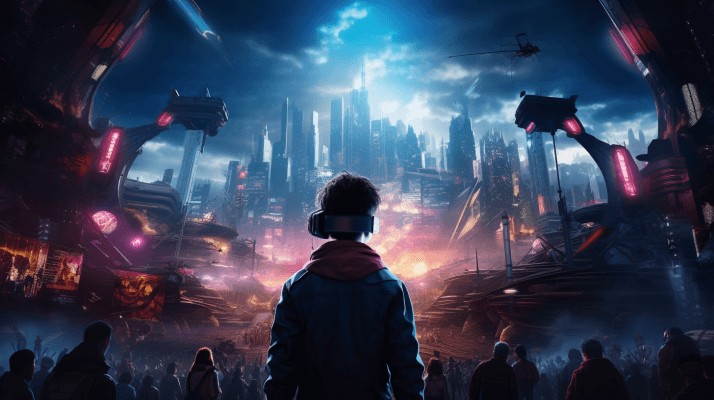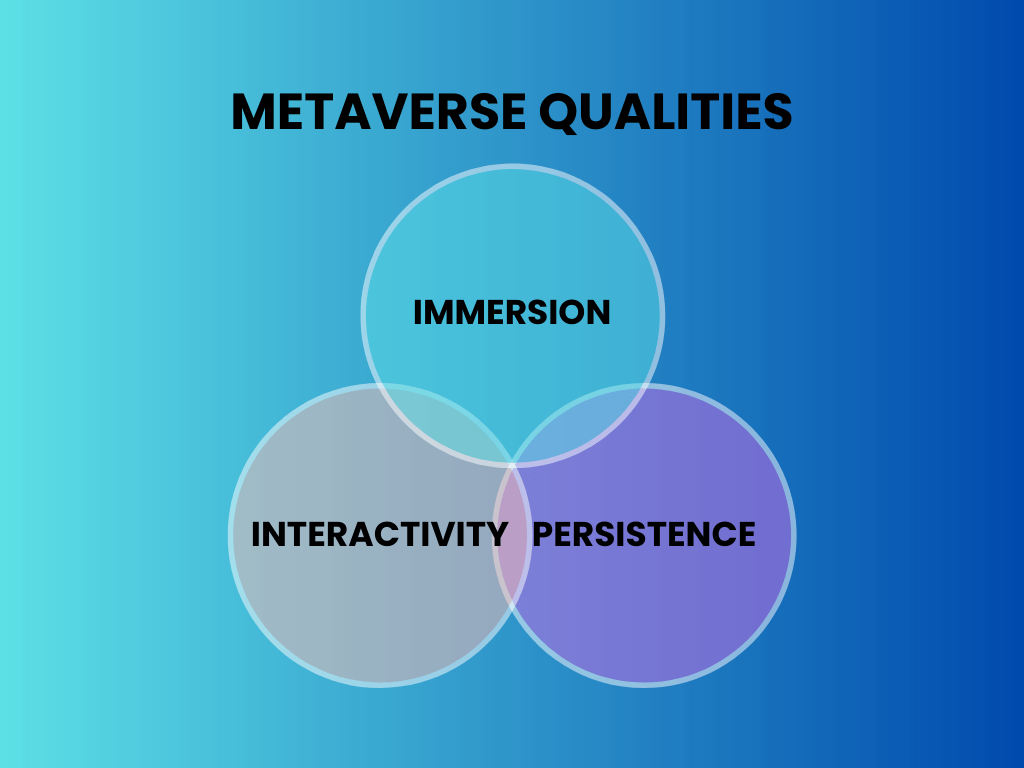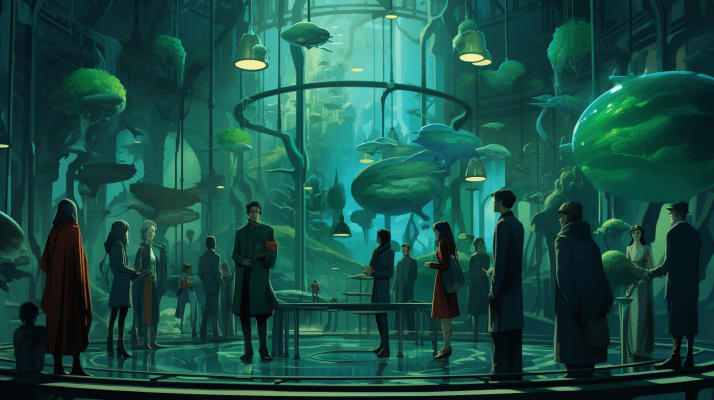For those interested in the new tech, the term “metaverse” is far from fresh. It’s been actively used, discussed, and written about by many over the last couple of years, with probably AI advancements stealing its thunder this year.
For some, the metaverse is something close to what was shown in the dystopian science fiction film adaptation “Ready Player One”, where the world in 2045 is drowning in an energy crisis and global warming with the only virtual escape-Oasis, functioning as a society and a video game. And actually, the idea is pretty close, apart from the severity of external conditions, though it’s not 2045 yet.
Jokes aside, on a more optimistic note, the very idea of a digital world might seem very effective and logical in the times of pandemic lockdowns, as it was in 2021 when Mark Zuckerberg shared his vision of the future with the metaverse. The virtual space for sharing unique experiences with people all over the world sounds very promising.
How will the metaverse transform the world we know today? How will it affect businesses? There are many more questions to ask and only hypothetical answers to get. Let’s take a look at what we already know and what changes are already here.
Contents:
2. What are the key features of the metaverse?
3. How will the metaverse affect the business world?
4. How can companies benefit using the digital capabilities of the metaverse?
5. What industries are affected by the metaverse most?

What is the metaverse?
The term “metaverse” refers to a hypothetical iteration of the internet as a single, universal and immersive virtual world that is created with the help of using virtual reality (VR) and augmented reality (AR) headsets. If that helps to really understand it. Simply said, the metaverse is a network of 3D virtual worlds that are created to promote social and economic interaction and a buzzword or an over-hyped term for many. The metaverse can be seen as any tech solution fostering the merge between the digital and physical worlds. No matter what exactly you mean saying “the metaverse”, the fact that it’s swiftly becoming a mainstream thing is undeniable.
One early example and pioneer of virtual reality worlds is a multimedia platform Second Life that was launched in 2003 and has 70 million registered accounts. Second life allows its users to create avatars and interact in the digital world, using its own currency, which is pretty close to the social aspect of the metaverse, described by Meta. According to Mark Zuckerberg and his immersive video presentation back in October 2021, the metaverse is a virtual reality “that will enable richer experiences by adding new layers to the existing world.” While the work is still in progress, more and more aspects of our real lives are going to be reflected in the metaverse. Zuckerberg talked about a new digital ecosystem, which will be shared by everyone. Today, though, it’s safe to talk about multiple multiverses as various companies (Meta, Microsoft, Roblox, Epic Games, Nvidia, Sony, Tencent, Google) are working on their own metaverses, which aren’t yet connected. These companies are developing different technologies that are and will be used to build the metaverse, such as VR headsets, AR headsets, and blockchain-based platforms. Some of them are focusing on gaming aspects, social connections, some others are creating complete metaverse platforms. As of today, it is too early to say how and when the metaverse will ultimately be fully developed, but it is clear that it is a technology with a huge potential to transform many aspects of our lives, including the way we do business.
What are the key features of the metaverse?
The main idea of the metaverse creation is to make all the life experiences feel real in comparison to what we see now on the flat screens of various devices. “So everything we do now online, work, socialize, play games is going to be more natural and vivid”, according to Mark Zuckerberg and his vision of the metaverse.
Thus, the metaverse has some key features to provide this real life similarity.
- Immersion is one of the features that enables users to feel like they are actually present in the virtual world by tracking their head and eye movements and providing them with haptic sensations. VR and AR tech is responsible for immersion in the first place.
- Interactivity is the feature that allows users to interact with each other and the environment in a meaningful way, including experiences of playing games, attending events, or even exploring the virtual world.
- Persistence means that the metaverse will continue to exist and evolve even when users aren’t logged in, which makes users’ actions have a lasting impact on the world.

How will the metaverse affect the business world?
Given the potential of the metaverse to be a powerful communication, collaboration and entertainment tool, the way it can and possibly will affect the business world is hard to underestimate.
It’s a fact that over the last 2-3 years companies around the globe have shifted to more digitized practices, remote work, using tech solutions to reach various goals, ranging from personnel training and hiring to new product development, and business efficiency monitoring. That means that the metaverse tech capabilities will significantly amplify that shift toward the digital world.
How can companies benefit using the digital capabilities of the metaverse?
- Boosting customer engagement
Using the metaverse capabilities might help companies discover new ways to engage with their customers. Virtual worlds where customers will interact with products and services in a more immersive way can surely build stronger relations. The metaverse can also be used to provide customer support in a more interactive way via virtual customer service representatives who can help customers with their problems in real time.
- Impact on employee productivity
The metaverse can foster employee training with AR and VR tech, which will help employees learn new skills without the necessity to travel, thus improving employee productivity. Horizon Workrooms by Meta, for example, provides a more immersive workspace with possible workroom customization, where business meetings can be visited by everyone in the form of a hologram or avatar, which should further facilitate hybrid ways of work. Another example is Walmart, which has successfully been using VR training for years, ensuring the needed level of employee qualifications across its multiple locations.
- Hiring with the help of the metaverse technologies
The metaverse potential can help various companies be more effective in addressing hiring and staff retention issues. It’s no surprise that according to Indeed survey, 88% of employers have conducted video interviews, which has its benefits to both sides. While employers noticed that they can accommodate many schedules and take better notes, employees benefit by saving time on travel and having a less intimidating experience. The metaverse can take such interviews to the next level of immersion. Assessing and testing skills and performance for different businesses can be much more effective in the virtual world as well.
- Impact on product development
The metaverse can help businesses develop new products and services by providing them with a digital platform to test and iterate on new ideas. It can take the shape of virtual prototype development and testing before their release to the market. BMW has already successfully developed its BMW iX, the first car that was developed with the help of gaming technology.

What industries are affected by the metaverse most?
Aside from the most obvious benefits of the metaverse tech for businesses described above, there are some industries that seem to be potentially affected by the metaverse more than others. It’s also obvious that real estate, education, healthcare, finance, logistics and manufacturing can and will benefit from embracing the metaverse potential as many other spheres. But the following three industries seem to be at the forefront of the metaverse revolution.
Gaming industry
The gaming industry can be considered one of the most immersive experiences so far. It’s already one of the biggest adopters of the metaverse, and it’s likely to be the first step into the metaverse for many people. Gaming companies are already using the metaverse to create new and immersive experiences for their players.
Collaborating on game development, marketing, or even creating cross-platform games between different gaming companies can be showcased on the example of Fortnite collaboration with Marvel, Star Wars, and DC Comics to create limited-time events and in-game items.
Successful work with tech companies results in new gaming hardware, software, or even virtual reality experiences. For example, Sony has collaborated with Epic Games to create the PlayStation VR headset, which allows gamers to experience VR games. So Epic games announced a $2 billion round of funding on the metaverse building with Sony, KIRKBI (investment company behind The Lego Group) as investors.
Overall, collaboration with entertainment companies resulted in super popular movies and TV shows based on the games, like “The Witcher” and “The Last of Us” for example.
Aside from gaming and entertainment, the gaming industry takes part in various collaborations with businesses to adapt gaming to some other goals, like car development and testing or live video concerts in video games, educational games and training programs, to mention just a few.
Fashion industry
As living in the metaverse means creating your avatar, wearing something is the inseparable part of it. The NY Times article “What to Wear in the Metaverse?” gives us a nice take on the fashion industry development in the metaverse.
There are no hard and fast rules about what to wear in the metaverse now, but as more and more people spend time and interact in the metaverse, there’s a growing demand for virtual clothing. This has led to the development of new businesses that sell digital clothing, including NFT wearables, as well as the emergence of new trends in virtual fashion. There are brands that produce only virtual clothing like DressX and brands that have virtual clothing in addition to their real life items like Gucci, Ralph Lauren, Balmain, Nike, Balenciaga and many others following the suit of embracing the metaverse trends.
On the whole, we can say that the metaverse grants us multiple opportunities to express ourselves in terms of how we look without the limitations of the physical world, but these opportunities can be potentially messy, as trying on different “selves” is much more than just a matter of fashion.

Retail
Retail industry is certainly the one already embracing the metaverse technologies and benefiting from its early adoption. Immersive commerce as a part of ecommerce is taking the world of retail a step further to see the bright future. Using VR and AR tech, immersive commerce has its aim to make shopping online a more realistic and enjoyable experience for the customers, which leads to stronger emotional ties and brand loyalty, boosting the KPIs.
There are many ways metaverse tech is already used by retail, but some of them are more successful and widespread now:
Virtual stores
The convenience of browsing the virtual store and interacting with products without even leaving home is a very enticing option, able to attract new clients and keep existing ones. Nike has created a virtual world called Nikeland on Roblox, where users can play games, customize their avatars, and even purchase virtual Nike products.
Virtual product try-on and product visualization experiences
Whether a part of a virtual store or just a virtual product showroom, this new experience allows customers to try on clothes, shoes, make up, see how new furniture will look in their homes or assess the new model of the car in different colors. As a result, customers make better purchase decisions and the number of returns reduces, which is a real win-win for both sides.
For instance, H&M has created a virtual fitting room in 2 flagship stores in Germany back in 2021 with 92% of users confirming that it helped them find out whether they liked the chosen clothes, and today the company is among many successfully using new tech across borders.
Virtual customer service
Customer service in the metaverse involves answering questions, resolving issues, and even providing live chat support with virtual brand representatives. It helps retailers improve customer satisfaction and reduce the number of calls to customer service.
Virtual brand awareness events
Hosting virtual events, such as fashion shows, product launches, and meet-and-greets with celebrities, can also be enhanced by integrating private live streaming platforms to build brand awareness and connect with customers on a more personal level. For example, HBO partnered with Snap AR and some of the best creators, designing and placing dragons in different locations around the world before the launch of the second season of “House of the Dragon”.
Digital goods and NFTs
Retailers can sell digital goods such as virtual clothing, accessories, cars, even homes. This is gradually gaining traction and could become a new revenue source for retailers, helping them reach a new audience of customers. NFTs or non-fungible tokens (giving you the ownership of the digital piece) are still quite new for an average user, but with the current pace of tech development, buying NFT can become as simple as buying a digital book.
Final thoughts
The metaverse is already here, even if it is in its initial stages, some VR and AR experiences can well be named the metaverse or metaverses now. We can’t even be sure that it’ll be called this way, but, according to Bernard Marr, it’s undoubtedly the next stage of internet evolution. It brings both, opportunities and challenges, as anything new and undiscovered. But the business world, being very adaptive, should address the challenges and learn to use the opportunities given by this brave new world.

%20(1).png)






Nice
Thank you!